Learn about the wildlife that live in and visit our islands.

|
Shetland
Wildlife
Learn about the wildlife that live in and visit our islands. |
|
|
Common Seals Common seals have nostrils that form a 'V'
shape with a short muzzle and a rounded head. They have a uniform
spotted coat with a paler underbelly. An adult is less than 6 feet long.
Moist eyes, known as a mask, are a sign that the seal is not
de-hydrated. The age of the seal is best determined by looking at the
teeth. To learn more visit |
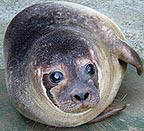 meet silver |
|
Grey Seals The grey seal's nostrils are
almost parallel with a long muzzle, a 'roman nose' in males. Their
colouring can vary, females have dark blotches on a light background and
males are generally dark all over. Adults can be more than 6 feet long.
When a seal is frightened the whites of the eyes show. To learn more
visit |
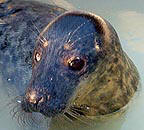 meet Isis |
|
This grey seal pup is jet black! Grey seals are born with a coat of pure white fur, which they moult after the first few weeks of life. This one, who was spotted at Uyea, Northmavine, will have had a shock when he saw his reflection! It's not uncommon for male seal pups to turn out black. |
 |
|
Hooded Seals Hooded seals live in the Arctic. This hooded seal probably floated south on an ice floe and then was washed ashore in Shetland. Hooded seals are extraordinary creatures. They weigh about 44 lbs when they are born, and their mother's milk is so rich that they double their weight in just four days when they are left to fend for themselves. |
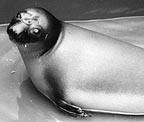 meet Ondine |
|
The picture of Ondine above shows her with a wet coat and in the one opposite her coat is dry. |
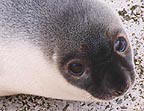 |
|
Bearded Seal Bearded seals also live in the Arctic. They grow to an enormous size and are clearly distinguished by their long whiskers which curl up when they are dry. They occasionally turn up in Shetland. |
 |
|
Leatherback Turtle The leatherback turtle has been around longer than the dinosaurs. Instead of a shell it has a carapace which can changed shape, allowing it to dive to great depths. These turtles grow up to 2.5 metres long even though their diet is ninety five percent jelly fish. They are black, spotted with white. |
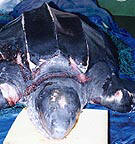 Meet Osiris |
|
Otters |
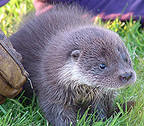 meet Amber |
|
Whales and Dolphins Whales, dolphins and
porpoises are regularly seen around Shetland's coastline and
occasionally strand on beaches.
|
 Pilot whales stranding at Urafirth |
We are a Scottish Charity - SC 020979 Website Design and Production by Spindrift Crafts Copyright Hillswick Wildlife Sanctuary